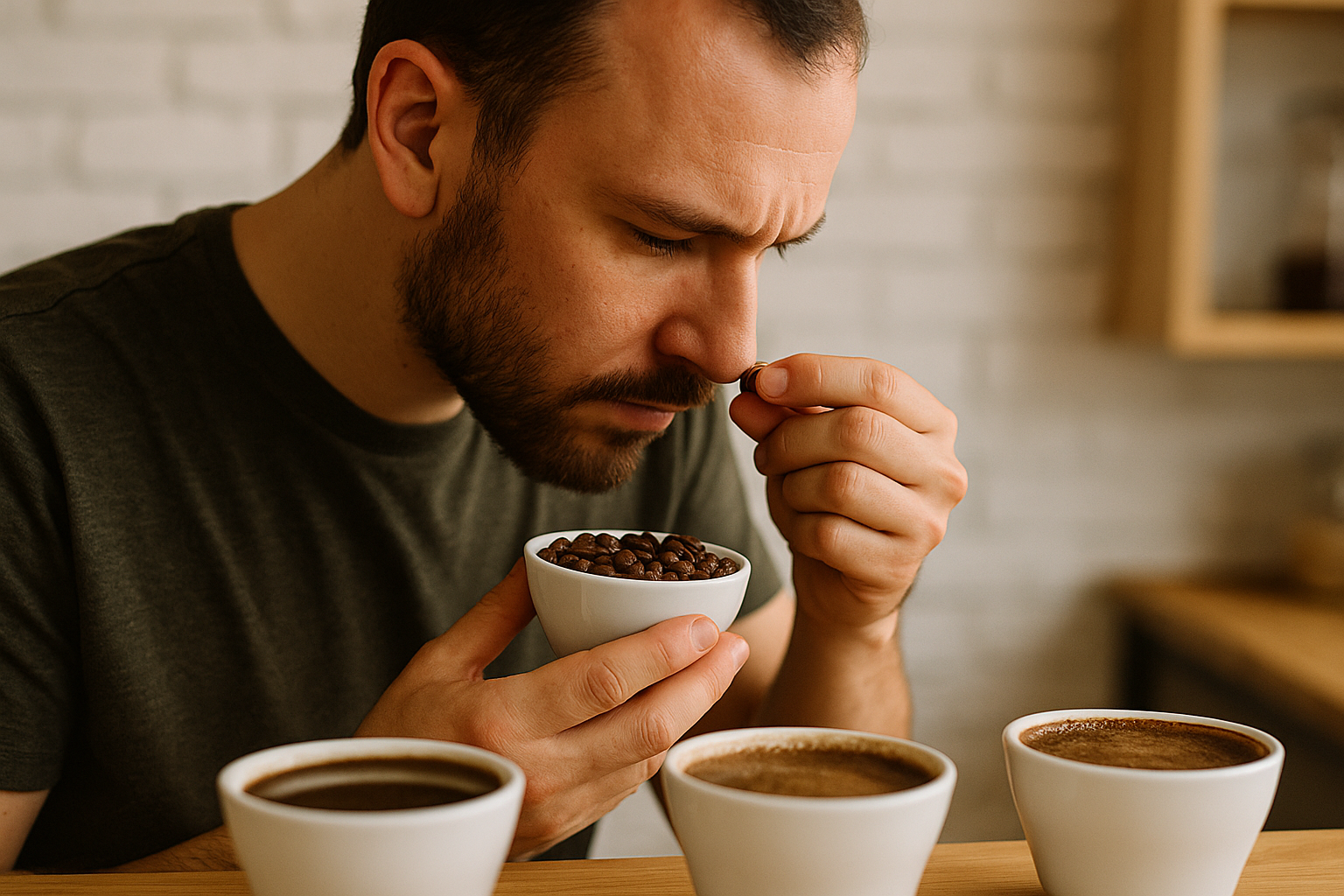One of the most important elements in specialty coffee — and often the most misunderstood — is the roast profile.
It’s the moment when raw, green coffee beans are transformed into the flavorful, aromatic coffee we all love. For baristas, understanding roast profiles is not just a technical skill — it’s essential to unlocking the full potential of every cup.
In this guide, you’ll learn what roast profiles are, how they affect taste and aroma, and how to use this knowledge to choose beans, brew correctly, and speak with confidence about flavor.
What Is a Roast Profile?
A roast profile is the specific pattern of time and temperature used during the coffee roasting process. It includes how quickly or slowly heat is applied, when key reactions occur, and how long the beans are roasted overall.
The roast profile determines how the chemical compounds inside the beans develop — and that directly affects the aroma, body, sweetness, acidity, and overall balance of the final coffee.
Roasters use different profiles to highlight specific characteristics of a coffee, whether it’s fruity, floral, chocolatey, or nutty.
The Main Roast Levels
Roast levels are often simplified into three main categories, but within each, there’s room for nuance. As a barista, you’ll often hear these terms used when selecting beans or describing flavor to customers.
Light Roast
- Color: Light brown
- Surface: Dry (no oils visible)
- Flavor: Bright acidity, complex, fruity or floral notes
- Body: Light to medium
- Best for: Pour-over, AeroPress, filter brewing
Light roasts preserve the bean’s origin character. You’ll taste the influence of the varietal, altitude, and processing more clearly.
Medium Roast
- Color: Medium brown
- Surface: Dry to slightly oily
- Flavor: Balanced between acidity and sweetness; chocolate, caramel, and nutty notes common
- Body: Medium
- Best for: All-purpose brewing — espresso, drip, immersion
Medium roasts are versatile and appeal to a wide range of palates. They maintain some origin character while adding roast complexity.
Dark Roast
- Color: Dark brown to almost black
- Surface: Oily
- Flavor: Bitter, smoky, roasty, with lower acidity
- Body: Full
- Best for: Espresso, milk-based drinks, cold brew
Dark roasts often mask the bean’s origin, replacing it with bold, roast-dominant flavors. They’re forgiving in espresso machines but can overpower subtle notes.
Understanding the Roasting Curve
The roasting process follows a temperature-time curve with several key phases. Here’s what happens inside the roaster:
1. Drying Phase
- First few minutes of roasting
- Beans lose moisture and begin turning yellow
- No significant aroma or color change yet
2. Maillard Reaction
- Begins around 150–160°C (302–320°F)
- Beans start browning
- Sugars and amino acids react to form flavor and aroma compounds
- Key to developing sweetness and complexity
3. First Crack
- Around 195°C (383°F)
- Beans expand and make a popping sound
- Signals the beginning of light roast
- Acidity and brightness peak here
4. Development Phase
- Time after first crack
- Flavors deepen and body increases
- Sweetness and balance develop
- Critical for roast quality
5. Second Crack (in darker roasts)
- Around 224°C (435°F)
- Louder cracks indicate breaking down of cellular structure
- Beans become shiny, oils emerge
- Roast flavor dominates origin characteristics
Each roast level corresponds to how long the beans are kept in this final development stage. A few seconds can dramatically change the flavor outcome.
How Roast Affects Flavor and Aroma
Roast profile is one of the biggest contributors to a coffee’s taste. Here’s how it influences different elements:
- Acidity: Higher in light roasts; reduced in darker roasts
- Sweetness: Peaks in medium roasts; drops off if roasted too long
- Bitterness: Increases with roast level
- Body: Generally fuller in darker roasts due to caramelization
- Aroma: Light roasts offer floral and fruity aromas; darker roasts give smoky, nutty, or spicy aromas
Roast doesn’t just change the taste — it changes how the coffee feels in your mouth and how it pairs with milk or food.
Choosing the Right Roast for Your Brew Method
Matching roast to brew method is a great way to get the best results. Here are some common pairings:
- Pour-over (V60, Chemex): Light or medium roast to preserve clarity and complexity
- French Press: Medium or dark roast for richer body and boldness
- Espresso: Medium-dark roast for balance between strength and sweetness
- Cold Brew: Dark roast to maintain body and reduce acidity
That said, there are no rules — only guidelines. Taste, adjust, and experiment based on your preferences and your customer base.
Roast Date vs. Freshness
A common misconception is that “fresh” coffee is always better. But coffee needs a few days to degas after roasting — the release of carbon dioxide trapped in the bean.
The sweet spot for most coffee is:
- 3 to 14 days after roasting for espresso
- 3 to 21 days for filter or immersion methods
After that, flavor begins to degrade. Knowing your roast date helps you plan and rotate stock — especially important in a café.
Roast and Extraction Variables
Roast level changes how you extract coffee. Light roasts are more dense and resistant to water. They often need:
- Finer grind
- Higher water temperature (92–96°C)
- Longer brew time
Dark roasts are more porous and extract quickly. They need:
- Coarser grind
- Lower temperature (88–92°C)
- Shorter brew time
As a barista, adjusting these variables helps you get the most out of each roast. It’s also why you can’t just use the same settings for every coffee — roast matters.
Communicating Roast Profiles to Customers
Many customers are familiar with “light,” “medium,” and “dark,” but may not know what that really means. Use simple, descriptive language to guide them.
Instead of saying, “This is a light roast,” try:
“This coffee is lightly roasted to bring out the natural fruit and floral notes. It’s bright and complex.”
Or:
“This medium roast balances sweetness and body — you’ll taste hints of chocolate and caramel.”
Your job isn’t just to serve coffee. It’s to translate what’s in the cup in a way that connects with the person drinking it.
Roasting for Milk Drinks vs Black Coffee
Roast profile also affects how coffee performs in milk drinks:
- Light roasts often get lost in lattes or cappuccinos
- Medium roasts provide balance — sweetness and acidity still shine
- Dark roasts cut through milk with bold, chocolatey intensity
If your café focuses on milk-based drinks, a medium-dark roast might work best for your espresso. If you specialize in pour-over, light roasts allow the coffee’s origin to shine.
How to Evaluate Roast Quality
When cupping or tasting, evaluate roast quality by asking:
- Does the roast highlight or mask the bean’s origin?
- Are there any signs of roast defects? (burnt, baked, grassy)
- Is the sweetness present and balanced?
- Does the coffee finish clean or bitter?
A well-roasted coffee enhances what’s already in the bean. A poorly roasted one covers it up.
Final Thoughts: Roast Profile Is a Barista’s Compass
Understanding roast profiles transforms the way you brew, taste, and talk about coffee. It gives you the ability to:
- Select the right bean for the right drink
- Adjust brew variables with purpose
- Describe flavor clearly and accurately
- Appreciate the roaster’s craft
As a barista, roast is not just a background detail — it’s the bridge between farm and flavor. Master it, and you’ll elevate every cup you serve.

Marcelo Rodrigues is a passionate barista with over 7 years of experience in specialty coffee. He’s worked in top cafés, led barista training sessions, and now shares practical tips to help beginners and coffee lovers improve their skills. Through this blog, Marcel makes the world of coffee more accessible—one cup at a time.

